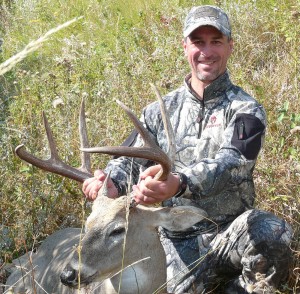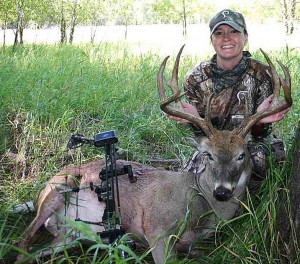April 10, 2012
By Gordon Whittington
 I can't recall what I had for lunch yesterday, but I remember many details of an entire week back in November 1983. That's because I spent it in central Montana, looking for a big whitetail.
I can't recall what I had for lunch yesterday, but I remember many details of an entire week back in November 1983. That's because I spent it in central Montana, looking for a big whitetail.
On what was my first out-of-state deer hunt, friends Tommy Witt and Benton Floerke, along with Benton's cousin, Sammy, joined me north of Billings for one of the most satisfying weeks I've ever spent in the outdoors. We four Texans had a blast roaming Big Sky Country, looking at fine scenery, meeting new people and observing hundreds of deer.
Montana was just starting to become known as a whitetail mecca. Of course, it long had been seen as a hotspot for "western" big game, from bighorn sheep and mountain goats to elk, mule deer, bears and pronghorn antelope. My buddies and I were among the few guys crazy enough to travel 1,200 miles in search of the same kind of deer we had in our own backyards.
We shot several mature bucks. They weren't necessarily more impressive than what we'd have tagged had we all stayed home to hunt; as my dad pointed out when I'd made it back to Texas with my Montana buck, "You could have shot one that size around here." But that of course wasn't the whole point of going to Montana. We loved the overall experience and found it well worth the time, money and effort. The fact I remember so many details nearly 30 years later is testament to that.
Advertisement
I'm occasionally still asked how Montana stacks up as a whitetail destination. I think it's in part because you don't see as much mention of the state's whitetails on TV shows or in hunting magazines. Aside from Realtree's frequent TV coverage of the herds along one stretch of the Milk River bottoms, as well as North American Whitetail Television's own hunts with Trophies Plus Outfitters in the state's southeastern corner, there just isn't a lot on Montana whitetails out there these days.
When asked why Montana has begun to fade from view, my typical response is something along the lines of, "It's still really good. The reason you probably don't hears as much about Montana is that a lot of other hotspots have come onto the scene since then."
Advertisement
This take isn't meant as a slight to the Treasure State. Not at all. Montana is indeed a really good whitetail state. Depending on your frame of reference, it might even be called "great" or "unbelievably awesome." But again, since I first hunted there, far more states and provinces have popped onto the whitetail community's collective radar.
As recently as 1980, from a nonresident's perspective nearly all of the chatter was about Texas, with the occasional shout-out to the big woods of Maine. There really weren't many other places an out-of-state whitetailer would consider trying. (Neither Iowa nor Kansas -- two of today's best producers of world-class whitetails -- even allowed nonresidents to hunt deer back then.) Among the few folks who ever left their own state to hunt whitetails, most did so in order to go back home and hunt with family and friends. Among those adventurous types who traveled to totally "foreign" places to hunt, the overwhelming majority were Easterners, Midwesterners or Southerners looking for an elk, mule deer or antelope out west. Not many were traveling across multiple time zones in search of a whitetail, big or otherwise.
What prompts me to reminisce about this is a recent article in the Missoulian, published in the western Montana city of Missoula. In it, the author, Rob Chaney, puts forth the argument that Montana isn't necessarily a hotspot if you're looking for a "trophy" whitetail. As he notes, according to recent Boone and Crockett records, "Montana hunters turned in five Boone and Crockett-quality racks between 2005 and 2010. That put Montana in a three-way tie for 37th place, with Alabama and North Carolina - and just ahead of Connecticut and New Hampshire, with four apiece."

Judging from those numbers, you'd think Montana is in the tank. But as we all know, record-book entries don't always tell the full story. Regardless of the official number of B&C racks of late, Montana still has plenty of big whitetails. From the evergreen forests on the west side to the ranch country of central Montana and the sweeping prairies and river bottoms in the east, there are untold miles of good habitat. And that habitat holds a lot of quality whitetails.
Part of the shortage of B&C entries, perhaps, is due to the fact many resident Montanans -- especially those living in rural areas -- have little access to official measurers. You might think this odd, as the Boone and Crockett Club is itself headquartered in Missoula. However, Montana is a huge state, and nearly all of it is sparsely populated. In most areas, you have to go to some trouble to get a deer or other big-game trophy measured. And there's no major annual hunting event, such as you'll find in many places farther east, to which hunters can bring big game for measuring. Put it all together and Montana's overall trophy output is way underrepresented in the whitetail records.
The success photos in this article attest to the fact Montana remains a whitetail hotspot. Whether you're going in early bow season or hunting the November rut with rifle, there are a lot of great spots and a lot of attractive bucks. The fact these deer aren't often showing up in the record books or in the popular media doesn't mean they don't exist.
Of course, as with any other state or province's whitetail population, there are challenges. And they start with a couple of things that are quite deadly. One is a virus; the second is an apex predator. We're talking, respectively, about epizootic hemorrhagic disease (EHD) and the gray/timber wolf.
EHD, which is spread by biting gnats in late summer and early autumn, periodically decimates pockets of whitetails in the state. It happened again last year, with thousands of deer dying from it in bow season. When it strikes, there's little anyone can do but hope it passes quickly and doesn't flare up again for at least several years.
Wolf predation is, by virtue of politics and practicality, a much stickier wicket. The ongoing legal battle over hunting these killers fortunately is shifting toward population control, including hunting. But just because wolves are legal to shoot at certain times doesn't make them easy to manage. In Montana, hunters this winter fell well short of the 220-animal quota set by the state; the reported harvest was 166. Wolves are smart, live in hard-to-get-to places and run in packs that give them even more of an edge against being caught unaware. Meanwhile, they clear out deer after deer after deer (not to mention other animals), drastically reducing the populations of some prey species.
Despite such issues, Montana remains a great whitetail destination, and one of great beauty. Much like it's fellow Rocky Mountain states of Idaho, Wyoming and Washington, as well as Canada's British Columbia, it's among the more rugged places in which the species lives. But you need not be a mountaineer to be successful here. Even if you don't care to trudge up heavily timbered slopes, there are plenty of flat farmland and gentle prairie river to consider.
Granted, Montana's nonresident deer permits aren't easy to draw. Nor are they inexpensive -- at over $500, they're actually among the very priciest in the world. But if you enjoy having plenty of elbowroom and seeing plenty of bucks, this remains a hard state not to like.

